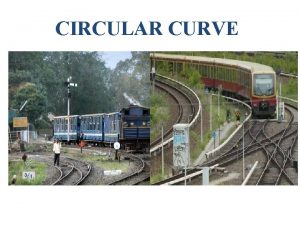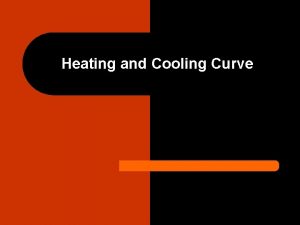Exam Curve and Some Statistics Curve for exam



































- Slides: 35

Exam – Curve and Some Statistics • Curve for exam and overall midterm grades A: ≥ 75 B: ≥ 60 C: ≥ 40 D: ≥ 25 Average for all 3 sections: 48. 2 Average for our section: 51. 1 In general, students tend to see grades go slightly down later in the course unless they put more time and effort into studying and doing problems. Slide 8 -1

Section 8. 1 Torque and Static Equilibrium (cont. ) © 2015 Pearson Education, Inc.

Recall - Torque and Static Equilibrium • There are two conditions for static equilibrium on an extended object: • The net force on the object must be zero. • The net torque on the object must be zero. • There is no net torque around any pivot point – as such, you usually want to pick a point where you know the least about the forces. © 2015 Pearson Education, Inc. Slide 8 -3

Quick. Check 8. 2 • What does the scale read, assuming it is halfway between the 1000 N weight, and the fixture? • (Hint – Choose a pivot point where you know the least about the force. ) A. B. C. D. 500 N 1000 N 2000 N 4000 N © 2015 Pearson Education, Inc. Slide 8 -4

Quick. Check 8. 2 • What does the scale read, assuming it is halfway between the 1000 N weight, and the fixture? A. B. C. D. 500 N 1000 N 2000 N 4000 N . © 2015 Pearson Education, Inc. Slide 8 -5

Example 8. 4 Will the ladder slip? A 3. 0 -m-long ladder leans against a wall at an angle of 60° with respect to the floor. What is the minimum value of μs , the coefficient of static friction with the ground, that will prevent the ladder from slipping? (Assume that friction between the ladder and the wall is negligible, and that the ladder is uniform. ) © 2015 Pearson Education, Inc. Slide 8 -6

Example 8. 4 Will the ladder slip? (cont. ) The ladder is a rigid rod of length L. To not slip, both the net force and net torque on the ladder must be zero. PREPARE The figure shows the ladder and the forces acting on it. What is a good choice for a pivot point? © 2015 Pearson Education, Inc. Slide 8 -7

Example 8. 4 Will the ladder slip? (cont. ) SOLVE The x- and y-components of are The torque about the bottom corner is © 2015 Pearson Education, Inc. Slide 8 -8

Example 8. 4 Will the ladder slip? (cont. ) Altogether, we have three equations with the three unknowns n 1, n 2, and fs. If we solve third equation for n 2, we can then substitute this into the first equation to find © 2015 Pearson Education, Inc. Slide 8 -9

Example 8. 4 Will the ladder slip? (cont. ) Our model of static friction is fs ≤ fs max = μsn 1. We can find n 1 from the second equation: n 1 = Mg. From this, the model of friction tells us that Comparing these two expressions for fs, we see that μs must obey Thus the minimum value of the coefficient of static friction is 0. 29. © 2015 Pearson Education, Inc. Slide 8 -10

Example 8. 4 Will the ladder slip? (cont. ) You know from experience that you can lean a ladder or other object against a wall if the ground is “rough, ” but it slips if the surface is too smooth. 0. 29 is a “medium” value for the coefficient of static friction, which is reasonable. ASSESS © 2015 Pearson Education, Inc. Slide 8 -11

Section 8. 2 Stability and Balance © 2015 Pearson Education, Inc.

Stability and Balance • An extended object has a base of support on which it rests when in static equilibrium. • A wider base of support and/or a lower center of gravity improves stability. © 2015 Pearson Education, Inc. Slide 8 -13

Stability and Balance • As long as the object’s center of gravity remains over the base of support, torque due to gravity will rotate the object back toward its stable equilibrium position. The object is stable. • If the object’s center of gravity moves outside the base of support, the object is unstable. © 2015 Pearson Education, Inc. Slide 8 -14

Conceptual Example 8. 5 How far to walk the plank? A cat walks along a plank that extends out from a table. If the cat walks too far out on the plank, the plank will begin to tilt. At what point does this happen? © 2015 Pearson Education, Inc. Slide 8 -15

Conceptual Example 8. 5 How far to walk the plank? ANSWER The cat will cause the board to tilt when the combined center of gravity of the cat-board system is over the edge. An object is stable if its center of gravity lies over its base of support, and unstable otherwise. REASON © 2015 Pearson Education, Inc. Slide 8 -16

Conceptual Example 8. 5 How far to walk the plank? (cont. ) When the cat is near the left end of the plank, the combined center of gravity is over the base of support, hence stable. As the cat moves right, he reaches a point where the combined center of gravity is directly over the edge of the table. If the cat takes one more step, the system will become unstable and the plank will begin to tilt. © 2015 Pearson Education, Inc. Slide 8 -17

Example Problem A 2 -m-long board weighing 50 N extends out over the edge of a table, with 40% of the board’s length off the table. How far beyond the table edge can a 25 -N cat walk before the board begins to tilt? © 2015 Pearson Education, Inc. Slide 8 -18

Stability and Balance of the Human Body • As a human moves, the body’s center of gravity is constantly changing. • To maintain stability, people unconsciously adjust the positions of their arms and legs to keep their center of gravity over their base of support. • When the woman stands on her tiptoes, she leans forward, readjusting her center of gravity to be over the balls of her feet (her base of support). © 2015 Pearson Education, Inc. Slide 8 -19

Try It Yourself: Impossible Balance Stand facing a wall with your toes touching the base of the wall. Now rise onto your tiptoes. You will not be able to do so without falling backward! As we saw previously, your body has to lean forward to stand on tiptoes. With the wall in your way, you cannot lean enough to maintain your balance, and you will begin to topple backward. © 2015 Pearson Education, Inc. Slide 8 -20

Try It Yourself: Balancing a Soda Can Try to balance a soda can—full or empty—on the narrow bevel at the bottom. It can’t be done because, either full or empty, the center of gravity is near the center of the can. If the can is tilted enough to sit on the bevel, the center of gravity lies far outside this small base of support. However, if you put about 2 ounces (60 ml) of water in an empty can, the center of gravity will be right over the bevel and the can will balance. © 2015 Pearson Education, Inc. Slide 8 -21

Section 8. 3 Springs and Hooke’s Law © 2015 Pearson Education, Inc.

Springs and Hooke’s Law • We have assumed that objects in equilibrium maintain their shapes as forces and torques are applied to them (i. e. that the are rigid). • This is an oversimplification; every solid object stretches, compresses, or deforms when a force acts on it. © 2015 Pearson Education, Inc. Slide 8 -23

Springs and Hooke’s Law • A restoring force is a force that restores a system to an equilibrium position. • Systems that exhibit restoring forces are called elastic. • Springs and rubber bands are basic examples of elasticity. © 2015 Pearson Education, Inc. Slide 8 -24

Springs and Hooke’s Law • The spring force and the displacement of the end of the spring have a linear relationship. (Fsp)x = – k Δx • The slope k of the line is called the spring constant and has units of N/m. © 2015 Pearson Education, Inc. Slide 8 -25

Springs and Hooke’s Law • Hooke’s law describes the most general form of the relationship between the restoring force and the displacement of the end of a spring. • For motion in the vertical (y) direction, Hooke’s law is (Fsp)y = –kΔy © 2015 Pearson Education, Inc. Slide 8 -26

Quick. Check 8. 3 The restoring force of three springs is measured as they are stretched. Which spring has the largest spring constant? © 2015 Pearson Education, Inc. Slide 8 -27

Quick. Check 8. 3 The restoring force of three springs is measured as they are stretched. Which spring has the largest spring constant? A. © 2015 Pearson Education, Inc. Steepest slope. Takes lots of force for a small displacement. Slide 8 -28

Example 8. 6 Weighing a fish A scale used to weigh fish consists of a spring hung from a support. The spring’s equilibrium length is 10. 0 cm. When a 4. 0 kg fish is suspended from the end of the spring, it stretches to a length of 12. 4 cm. a. What is the spring constant k for this spring? b. If an 8. 0 kg fish is suspended from the spring, what will the length of the spring be? © 2015 Pearson Education, Inc. Slide 8 -29

Example 8. 6 Weighing a fish (cont. ) The fish hangs in static equilibrium, so the net force in the y-direction and the net torque must be zero. PREPARE a. Because the fish is in static equilibrium, we have SOLVE so that k = –mg/∆y. (The net torque is zero because the fish’s center of gravity comes to rest directly under the pivot point of the hook. ) © 2015 Pearson Education, Inc. Slide 8 -30

Example 8. 6 Weighing a fish (cont. ) The displacement of the spring from equilibrium is ∆y = yf – yi = (– 0. 124 m) – (– 0. 100 m) = – 0. 024 m. This displacement is negative because the fish moves in the –y-direction. Solving for k gives © 2015 Pearson Education, Inc. Slide 8 -31

Example 8. 6 Weighing a fish (cont. ) b. The restoring force is proportional to the displacement of the spring from its equilibrium length. If we double the mass (and thus the weight) of the fish, the displacement of the end of the spring will double as well, to ∆y = – 0. 048 m. Thus the spring will be 0. 048 m longer, so its new length is 0. 100 m + 0. 048 m = 0. 148 m = 14. 8 cm. © 2015 Pearson Education, Inc. Slide 8 -32

Example 8. 6 Weighing a fish (cont. ) The spring doesn’t [Insert Figure 8. 15 stretch very much when a (repeated)] 4. 0 kg mass is hung from it. A large spring constant of 1600 N/m thus seems reasonable for this stiff spring. ASSESS © 2015 Pearson Education, Inc. Slide 8 -33

Example Problem A 20 -cm-long spring is attached to a wall. When pulled horizontally with a force of 100 N, the spring stretches to a length of 22 cm. The same spring is now suspended from a hook and a 10. 2 -kg block is attached to the bottom end. How long is the stretched spring? © 2015 Pearson Education, Inc. Slide 8 -34

Example Problem A spring with spring constant k = 125 N/m is used to pull a 25 N wooden block horizontally across a tabletop. The coefficient of friction between the block and the table is μk = 0. 20. By how much does this spring stretch from its equilibrium length? © 2015 Pearson Education, Inc. Slide 8 -35
 Introduction to statistics and some basic concepts
Introduction to statistics and some basic concepts Statistics and ethics: some advice for young statisticians
Statistics and ethics: some advice for young statisticians What are some contact forces and some noncontact forces
What are some contact forces and some noncontact forces Some may trust in horses
Some may trust in horses Introduction to statistics what is statistics
Introduction to statistics what is statistics They say it only takes a little faith to move a mountain
They say it only takes a little faith to move a mountain Sometimes you win some sometimes you lose some
Sometimes you win some sometimes you lose some Cakes countable or uncountable
Cakes countable or uncountable Some say the world will end in fire some say in ice
Some say the world will end in fire some say in ice Some say the world will end in fire some say in ice
Some say the world will end in fire some say in ice S curve and j curve
S curve and j curve S curve and j curve
S curve and j curve Fspos
Fspos Novell typiska drag
Novell typiska drag Tack för att ni lyssnade bild
Tack för att ni lyssnade bild Returpilarna
Returpilarna Varför kallas perioden 1918-1939 för mellankrigstiden
Varför kallas perioden 1918-1939 för mellankrigstiden En lathund för arbete med kontinuitetshantering
En lathund för arbete med kontinuitetshantering Adressändring ideell förening
Adressändring ideell förening Tidbok
Tidbok A gastrica
A gastrica Densitet vatten
Densitet vatten Datorkunskap för nybörjare
Datorkunskap för nybörjare Stig kerman
Stig kerman Debatt artikel mall
Debatt artikel mall Magnetsjukhus
Magnetsjukhus Nyckelkompetenser för livslångt lärande
Nyckelkompetenser för livslångt lärande Påbyggnader för flakfordon
Påbyggnader för flakfordon Lufttryck formel
Lufttryck formel Publik sektor
Publik sektor Bo bergman jag fryser om dina händer
Bo bergman jag fryser om dina händer Presentera för publik crossboss
Presentera för publik crossboss Argument för teckenspråk som minoritetsspråk
Argument för teckenspråk som minoritetsspråk Kanaans land
Kanaans land Klassificeringsstruktur för kommunala verksamheter
Klassificeringsstruktur för kommunala verksamheter Fimbrietratt
Fimbrietratt



























































